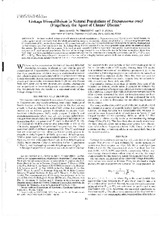Linkage disequilibrium in natural populations of Trypanosoma cruzi (Flagellate), the agent of Chagas'disease
Resumen
ABSTRACT.
We have studied linkage disequilibrium in natural populations of Trypanosoma cruzi, the agent of Chagas' disease, by analyzing (i) a set of 524 stocks from the whole geographical range of the parasite, characterized at four gene loci coding for enzymes; (ii) a subsample of 121 stocks characterized at 12 enzyme loci; and (iii) a subset of 386 stocks from six locations in Bolivia, characterized by four enzyme loci. Our results show that the linkage disequilibrium reaches the maximum possible value, given the observed allelic frequencies, for almost all the locus pairs. This result is most consistent with the hypothesis that genetic recombination is absent or very rare in T. cruzi natural populations, Partition of the linkage disequilibrium variance for the 'six Bolivian populations shows that both inter- and intrapopulation components are substantial and that the relationships among the components are D2 IS < D2 ST’ and D’IS < D'2ST These inequalities are interpreted as the result of an interplay between genetic drift, rare or absent mating, and clonal selection in generating linkage disequilibrium in T. cruzi populations.

